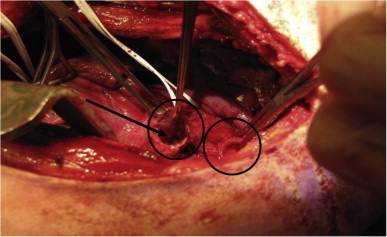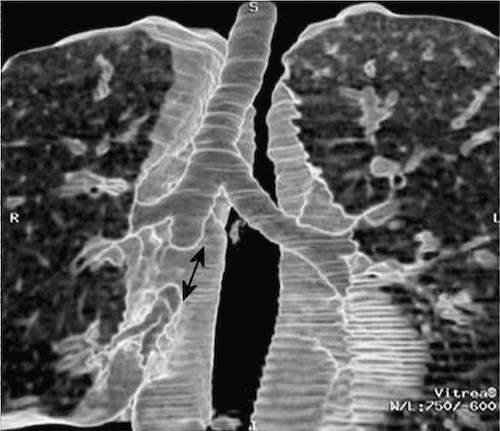Tracheobronchial Injury
Tracheobronchial Injury
David Ray Velez, MD
Table of Contents
Presentation and Diagnosis
Management
This Article Reviews Thoracic Tracheobronchial Injury
For Cervical Tracheal Injury: *See Neck Trauma
Presentation and Diagnosis
A Rare but Life-Threatening Injury
Most Common After High-Force Blunt Trauma – Motor Vehicle Crash (MVC)
Location
- Most Common in the Cervical Trachea
- Thoracic Injuries are Most Common on the Right
- Most (> 75-90%) Occur Within 1-2 cm of the Carina
Presentation
- Large Pneumothorax (PTX)
- Large Continuous Air Leak
- Can Potentially See SpO2 Drop After Chest Tube Placement if the Leak is Severe and Causes Significant Volume Loss – Consider Clamping Chest Tube if Not Causing Tension Physiology
- Persistent Pneumothorax Despite Chest Tube Placement
- Pneumomediastinum
- Subcutaneous Emphysema
- Respiratory Distress
- Hemoptysis
Complications
- Pneumonia (PNA)
- Sepsis
- Respiratory Failure
- Tracheobronchial Stenosis
Diagnosis: Bronchoscopy
CT Scan is Evolving and Can Be Used to Evaluate but Does Not Definitively Rule Out Injury

Left Main Bronchus Transection 1

Bronchial Transection 2
Management
Airway Management
- Consider Conservative Management if Airway is Maintained
- Tracheobronchial Injuries Frequently Present in Respiratory Distress Requiring Airway Control
- Extreme Caution with Intubation – Can Convert a Partial Injury to a Complete Disruption
- Airway Loss Can Cause Respiratory Arrest
- May Attempt Intubation Distal to The Injury or Mainstem Intubation of the Unaffected Side if the Injury is Distal
Surgical Repair is the Mainstay of Treatment for Tracheobronchial Injuries
May Consider Nonoperative Management for Small (< 2 cm, < 1/3 Diameter) Injuries without Respiratory Compromise
Surgical Approach
- Extrathoracic Injury: Cervical Incision
- Most Thoracic Injuries: Right Posterolateral Thoracotomy
- Distal Left Mainstem Injury (> 3 cm from Carina): Left Posterolateral Thoracotomy
Surgical Repair
- Simple Lacerations: Primary Repair
- Circumferential Disruption: End-to-End Anastomosis
- Can Generally Perform Primary Anastomosis for Injuries Up to 5-6 Tracheal Rings in Length with Mobilization
- Minimize Peritracheal Dissection to Preserve Blood Supply
- Extensive Injuries May Require Minimal Debridement
- Generally Repaired in a Single Layer with Absorbable Suture in Simple Interrupted Fashion
- 2-Layer Repairs Risk Stenosis
- Consider Reinforcement with a Vascularized Intercostal or Strap Muscle Flap (Particularly if Concomitant Esophageal or Vascular Injuries are Present)
Protective Tracheostomies are Generally Omitted in Modern Practice – Ideally Extubate in the Operating Room if Able
References
- Groenendijk MR, Hartemink KJ, Dickhoff C, Geeraedts LM Jr, Terra M, Thoral P, Hashemi SM. Pneumomediastinum and (bilateral) pneumothorax after high energy trauma: Indications for emergency bronchoscopy. Respir Med Case Rep. 2014 Jul 11;13:9-11.(License: CC BY-NC-ND-3.0)
- Oikonomou A, Prassopoulos P. CT imaging of blunt chest trauma. Insights Imaging. 2011 Jun;2(3):281-295. (License: CC BY-4.0)
